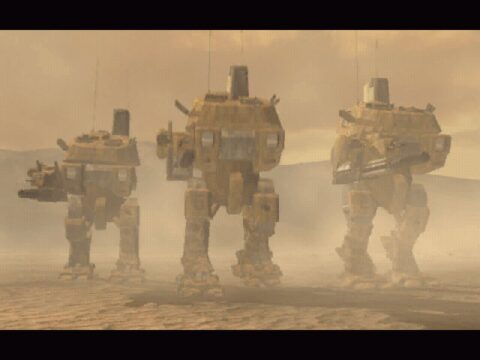
Command and Conquer: Tiberian Sun
Written by: Rik
Date posted: May 7, 2007
- Genre: Strategy
- Developed by: Westwood Studios
- Published by: Electronic Arts
- Year released: 1999
- Our score: 6
In this life, you can’t fight age. Deep down, we all know this, but for most of the time we’re happy to drift through the days, weeks and months of our humdrum existence in a near-permanent state of denial. So while you may think that ‘Emo’ is the stuffed animal that spent a considerable amount of time in the 1980s with Rod Hull’s hand shoved up its arse, and that though you may be able to get into a pair of skinny jeans if you laid off the booze and did some exercise once in a while, you can’t understand why you’d want to, as long as you can still recognise most of the songs on the radio and know that a Wii is not just what you’ll need if you sink a couple of pints and then get on the Underground, it’s not really time to worry yet.
Occasionally, this relatively blissful state is interrupted. You can expect a few days of paralysing fear and crippling depression every time a birthday comes along, for example – which is at least quite predictable. At other times, you’re reminded of your age by suddenly realising something horrible – like the fact that the first Command and Conquer game was released in 1995, which (at the time of writing) is TWELVE years ago. And if that wasn’t bad enough in itself, it then gives birth to lots of other horrible little thoughts – such as, for example, that there are lots of kids out there playing games now who WEREN’T EVEN BORN when C&C first came out. Argh!
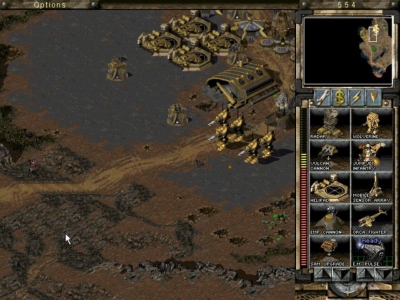
The name of the game is still stockpiling a bunch of units until you’re confident you can crush the enemy.
Old it (and I) may be, but it remains incredibly popular, and even the most die-hard retro-bore will be aware of the fact that there’s a new one (C&C 3 – Tiberium Wars) out at the moment. Graphics aside, by all accounts it’s the same game it always was, yet it seems to have gone down a treat with the gaming press – which is interesting, considering the howls of protest that greeted Tiberian Sun on release. “It’s exactly the bloody same”, they groaned, amid claims of one-dimensional ‘build and rush’ gameplay – clearly, that’s back ‘in’ for 2007.
While gaming trends come and go, games bearing the Command and Conquer name remain largely the same. You set up a base, collect resources, train troops and build tanks and then go and try and kick the crap out of the other side until a robotic female voice tells you it’s ‘Mission Accomplished’. And so it is in Tiberian Sun. Leaving behind the pseudo-contemporary setting of Red Alert and returning to the futuristic global war between the Global Defence Initiative (America) and the Brotherhood of Nod (er, America) established in the first game, you can either elect to make the world safe for democracy or establish some kind of mad terror state, depending on your preferences. Once you’ve chosen your side, you can watch a few silly cut-scenes before getting right into the action.
The missions are fairly varied, although admittedly, they’re the kind of variations you’ll have seen before if you’ve played one of the previous games in the series. Sometimes you get the chance to build up a base and amass a huge force in the traditional manner, but at other stages in each campaign, you’ll have to protect certain units, defend your ground for a set period of time, or even take a handful of powerful units on a mission of stealth and destruction. There’s no great tactical edge to proceedings – there’s a certain a reliance on scripted events, and at times it’s clear that the game wants you to do things a certain way.
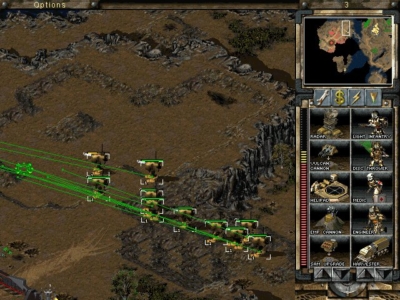
These helpful green lines tell you where your units are headed. Which should be where you just told them to go.
That’s always been the way in C&C though, and to be honest it would probably be more worthwhile here to try and describe what’s different this time around. The most obvious changes are to the game engine, with an isometric perspective replacing the top-down view present in previous titles. Despite attracting derision on release, the graphics have been improved, with the battlefield now more detailed than before, and featuring a few fairly nice touches such as coloured lighting and flying debris. On the negative side, voxels have been used for the units, and the usual shortcomings such as occasional blurring and loss of detail are apparent. It should also be mentioned that the new engine doesn’t really improve how the game plays, with obstacles coming, as before, in the form of nonnegotiable terrain or a knackered bridge.
Each side has a few new construction options and units – some of which, such as Nod’s Subterranean APC (which is able to transport a handful of units around undetected) are quite cool, while others are less so. For some reason GDI seems to have invested heavily in giant walking robots, which have always struck me as quite silly, and when you send a group of them lurching off towards enemy territory, a part of you expects them to be taken down by a group of small furry animals using a combination of ropes, logs and rocks. Give me a Mammoth Tank (also available later on) over one of those things any day.
In terms of new gameplay features, there’s not a lot else. You can now set waypoints for your units, although I can’t recall if this is a completely new feature or one that has just been made more prominent. Units can also now gain experience points during the course of a mission, which makes them more effective in both defence and attack. It’s supposed to act as an incentive to protect your little fellas rather than merrily sending them off to their death, but personally speaking I didn’t find this was worth the effort, especially as it all counts for nothing as soon as the mission is over.
And that’s about it. Put simply, it’s another Command and Conquer game: more of the same. To be honest, there’s nothing wrong with that, and if the latest game is still successfully following the same basic template, there’s no reason to criticise Tiberian Sun for doing so. Nevertheless, it has to be said that any enjoyment gleaned from the admittedly solid RTS fare on offer here is tempered throughout by a nagging sense of disappointment. It’s hard to really pinpoint the exact reasons – there certainly aren’t any technical flaws, apart from an annoying bug when your harvester seems to ‘give up’ and refuses to follow your instructions to get on with things (grr).
Still, here goes. At the time of release, even the most easily pleased of gamers might still have wondered exactly how the extensive development time had been spent. Since then, rumours have been circulating in internet-land that Westwood had something more ambitious in mind but later abandoned this in favour of the conventional RTS that eventually emerged. Exactly how much truth there is in this, I don’t know, but the game does feel suspiciously like a rush-job – a polished one, yes, but still something that seems like it was half-heartedly knocked together at the last minute rather than the fruit of three years’ hard work and development.
Generally, the ‘feel’ of the game is wrong. Where previous games in the series represented a brash, fast-paced, comic-book version of ‘playing war’, in comparison, Tiberian Sun feels a little flat and a little sluggish. The barnstorming musical score of previous titles has been replaced by unremarkable keyboard ‘musak’ and the tongue-in-cheek cut-scenes of old are now a little po-faced and cheesy (see A Day Long Remembered, for more). While these things may seem like minor details, they can be the difference between giving up and carrying on when the core game underneath is starting to feel a little tiresome.
If you know what to expect from Command and Conquer, there’s a chance you might be disappointed with Tiberian Sun, but there is still a solid game here, and the two campaigns do have their fair share of exciting moments to keep you interested, for a while at least. Newcomers to the series might be better advised to start with the original (or failing that, Red Alert) in order to see what all the fuss was about in the first place.

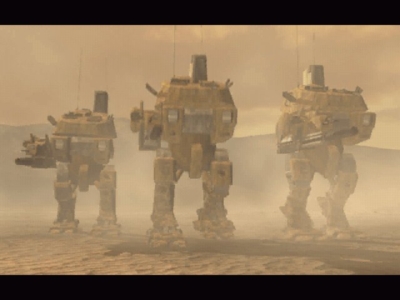
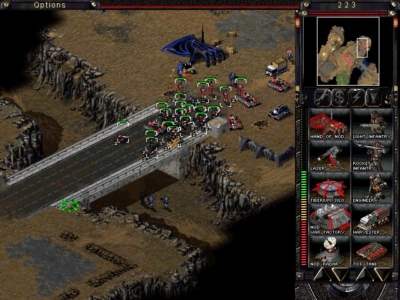

 Posts
Posts